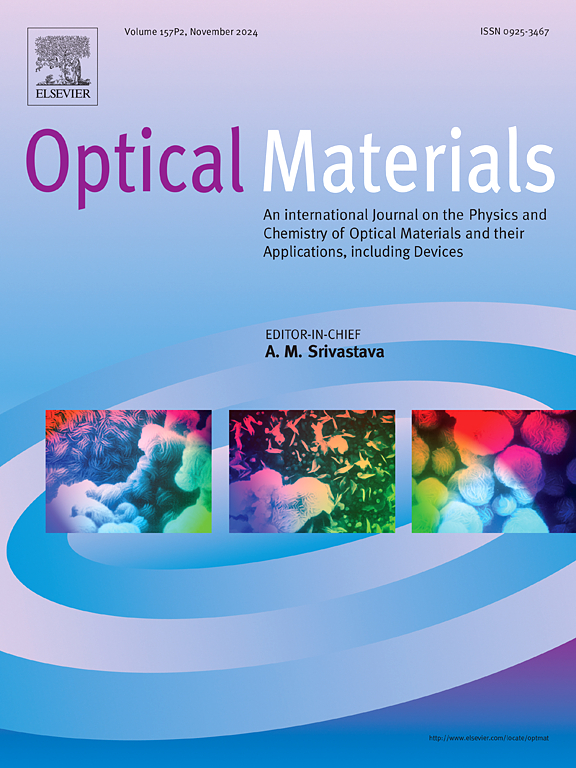基于CaGdGaO4:Yb3+,Er3+中Er3+离子Stark亚能级的热增强上转换发光和光学感温特性
IF 3.8
3区 材料科学
Q2 MATERIALS SCIENCE, MULTIDISCIPLINARY
引用次数: 0
摘要
在高温工作环境下,迫切需要具有热增强荧光的精确光学测温技术,以实现无创、高灵敏度的温度测定。本文研究了Er3+/Yb3+掺杂的CaGdGaO4 (CGGO)荧光粉在近红外激发下的热增强上转换发光(UCL)和热传感性能。UCL光谱在Er3+离子的2H11/2、4S3/2和4F9/2能级上呈现多个尖峰,这是由于晶体场Stark亚能级之间的电子跃迁引起的。通过引入Yb3+掺杂剂和调节不同的激发波长,成功地将样品的发射色从绿色调谐到红色。随着温度的升高,UCL强度大大增强,这得益于热增强的声子辅助效应。利用荧光强度比技术,在303-573 K的宽温度范围内,基于Er3+ Stark亚能级的热耦合能级(tcel)评估了温度传感性能。2H11/2(1)和4S3/2(2)在303 K下的最大相对灵敏度可达1.55% K−1,高于传统的2H11/2/4S3/2的tsel。光学温度计CGGO:Er3+,Yb3+显示了99%的高重复性和0.28 K的最低温度分辨率。我们的研究结果表明,具有热增强UCL的CGGO:Yb3+,Er3+荧光粉可以作为非接触和高灵敏度光学测温的候选材料。本文章由计算机程序翻译,如有差异,请以英文原文为准。
Thermal-enhanced upconversion luminescence and optical temperature sensing properties based on the Stark sublevels of Er3+ ion in CaGdGaO4:Yb3+,Er3+
Accurate optical thermometry with thermally enhanced fluorescence is urgently desired for non-invasive and high sensitivity temperature determination in high temperature operating environment. Here we explore thermally enhanced upconversion luminescence (UCL) and thermal sensing properties of Er3+/Yb3+ doped CaGdGaO4 (CGGO) phosphors under near-infrared excitation. The UCL spectra exhibit multiple sharp peaks from 2H11/2, 4S3/2, and 4F9/2 levels of Er3+ ions, arising from the electronic transitions between crystal-field Stark sublevels. The emission color of samples is tuned from green to red successfully by introducing Yb3+ dopants and adjusting different excitation wavelengths. The UCL intensity is greatly enhanced with the increase of temperature, which benefits from the thermally enhanced phonon-assisted effect. By using the fluorescence intensity ratio technique, temperature sensing performances are evaluated based on thermally coupled energy levels (TCELs) involving Stark sublevels of Er3+ over a wide temperature range of 303–573 K. The maximum relative sensitivity of 2H11/2(1) and 4S3/2(2) levels reaches up to 1.55 % K−1 at 303 K, which is higher than that of the traditional TCELs of 2H11/2/4S3/2. The optical thermometer CGGO:Er3+,Yb3+ shows a high repeatability of 99 % and minimum temperature resolution of 0.28 K. Our findings demonstrate that CGGO:Yb3+,Er3+ phosphors with thermal enhancement UCL can be used as candidates for non-contact and high sensitivity optical thermometry.
求助全文
通过发布文献求助,成功后即可免费获取论文全文。
去求助
来源期刊

Optical Materials
工程技术-材料科学:综合
CiteScore
6.60
自引率
12.80%
发文量
1265
审稿时长
38 days
期刊介绍:
Optical Materials has an open access mirror journal Optical Materials: X, sharing the same aims and scope, editorial team, submission system and rigorous peer review.
The purpose of Optical Materials is to provide a means of communication and technology transfer between researchers who are interested in materials for potential device applications. The journal publishes original papers and review articles on the design, synthesis, characterisation and applications of optical materials.
OPTICAL MATERIALS focuses on:
• Optical Properties of Material Systems;
• The Materials Aspects of Optical Phenomena;
• The Materials Aspects of Devices and Applications.
Authors can submit separate research elements describing their data to Data in Brief and methods to Methods X.
 求助内容:
求助内容: 应助结果提醒方式:
应助结果提醒方式:


